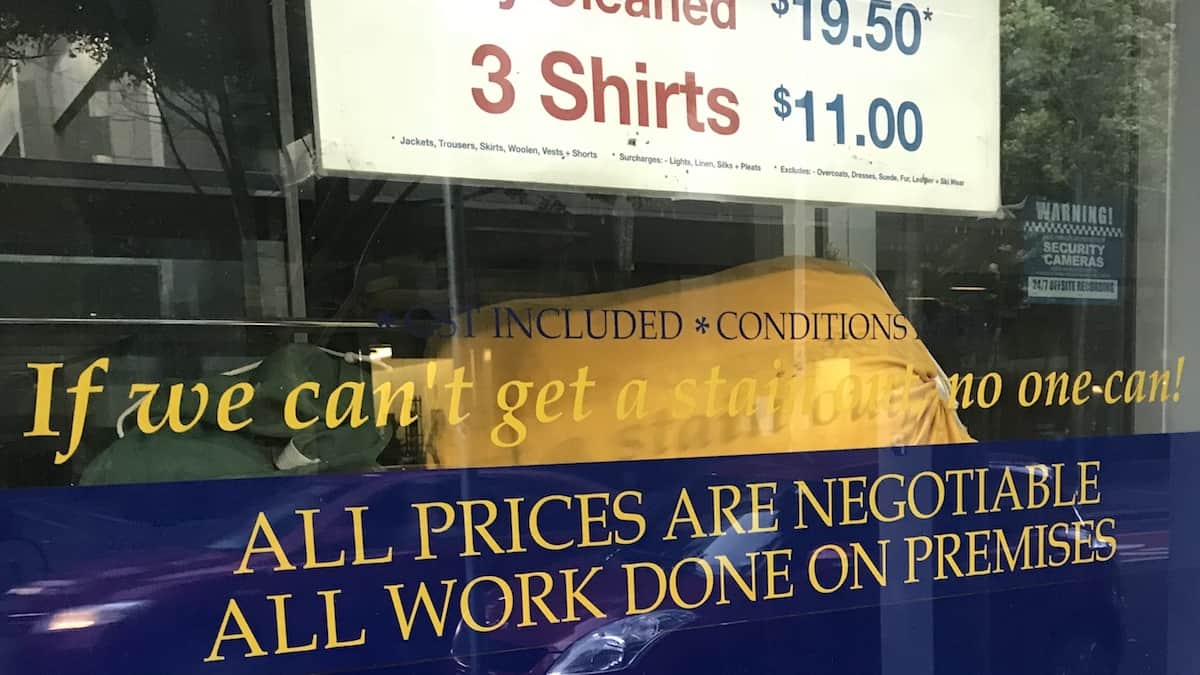Visiting Australia, I passed a dry cleaner in Sydney—and noticed a terrifying sign (see right). It said: “All Prices Are Negotiable.”
Are you telling your agency’s clients—directly or indirectly—that you’ll cut your prices for anyone who asks? Stop selling against yourself! You’re hurting your own profit margins—and your salespeople may be doing it, too.
Let’s define “selling against yourself,” examine why it’s bad, look at how you may be doing it with your sales prospects, and review how to stop. I’ve also included three “before & after” scenarios to illustrate how to fix things.
What is “selling against yourself”?
Selling against yourself is a sales mistake that hurts your profit margins—it’s when you volunteer to make price cuts without cutting the scope of what you’re delivering.
Selling against yourself is usually a combo of poor self-esteem, weak sales improv skills, and an inability to listen actively (and bite your tongue). It’s the sales version of an “unforced error” in sports—you didn’t have to make the mistake, but you made the easily avoidable mistake anyway.
Example of Selling Against Yourself
You’re selling against yourself when you tell a prospect you’ll charge less—potentially less than the minimum budget you know your agency needs to get results for clients.
- You: “Our minimum engagement is $50,000.”
- Prospect: “We were hoping to keep the budget to $10,000.”
- You [knowing that <$30K = unhappy clients]: “You know, we can do most of this for $10,000.”
Later in this article, I share the “after” version of how to preserve your dignity. I once learned a former client would offer a “friends and family” discount to nearly anyone. He had also given a non-profit discount to organizations that weren’t non-profits—the clients had done nothing to earn the discount. Ouch.
Keep in mind that “selling against yourself” isn’t downselling—downselling is an intentional sales technique, where you recommend a lower-scope, lower-priced option because the cheaper option is more suitable. This also isn’t about choosing to make something strategically free—where you choose to discount something (and call it out) because it helps you, too.
Why does “selling against yourself” hurt your profit margins?
You’re cutting prices without cutting the scope—which means you’re reducing revenue without reducing the labor involved. This is a profit-killing problem regardless of the pricing model you use:
- Hourly Pricing: When you lowball the hours estimate, you’re unlikely to finish the work you expected.
- Milestone Pricing: When you reduce milestone prices without cutting scope, you force your team to keep working on the milestone after the budget’s gone, or encourage people to cut corners on quality.
- Value-Based Pricing: In theory, your value-based price is far higher than what you’d get on a milestone basis, but you risk missing performance payments… or are guaranteed to lose margin via a lower value-anchored price.
Your daily choices add up—if last year’s net profit margins were lower than 20-30%, and your YTD margins also trending low, it’s because you’ve made a series of poor decisions along the way. As the agency owner, low profit margins are ultimately your fault—but you’re also empowered to fix the problem.
Let’s review what the problem might look like, and then how to fix it.
How you might be selling against yourself today
It’s normal to feel nervous in a sales setting—but it’s dangerous when feeling nervous leads to giving away the farm.
Don’t make an instant price reduction
Here’s how an instant price-cut might look in a sales conversation:
- You: “To get the results you want, our proposal is $120,000.”
- Prospect: “Wow, that’s a lot of money!”
- You: “Uh, what if we made it $100,000?”
In a section below, I share the “after” version that helps you keep that $20,000 for your bottom line.
Selling against yourself comes across as desperate—and some prospects will choose to exploit that further by actively requesting further price concessions. It’s OK to offer a lower-priced option—but tell the prospect you need to consult with your PM team first, to see what scope you’d need to cut.
Don’t shave your proposal prices
You also sell against yourself when you shave your proposal prices—without cutting scope—because you assume prospects can’t afford what you want to charge. Here’s how your internal meeting might go:
- Your VP-Delivery: “It looks like we can do the full scope for $140,000, and the reduced scope for $120,000.”
- You: “They don’t want to go over $100,000. Can we get the full-scope price down to $95,000?”
- Your VP-Delivery [calculating]: “We can reduce an even smaller scope to $95,000, but the full-scope can’t go below $130,000.”
- You: “They’re really nice people. I’m going to quote them $99,000 for the full scope; I’m sure we can find other ways to save money later.
- Your VP-Delivery [gritting their teeth]: “Sure!” [starts looking for a new job]
Below, I share an “after” version of how to handle that scenario without making your employees want to quit. Sometimes this is because you feel like you’d never pay the price. But remember that you’re not your clients, and they often have more money than you think.
Let’s look at new ways to handle the scenarios above—in ways that don’t involve selling against yourself.
“After” Scenarios: What to Do Instead
To create a “before & after,” I’ve “fixed” the earlier scenarios to eliminate selling against yourself!
Standing Firm on Your Minimum Budget
Stick to your guns! Try this instead:
- You: “Our minimum engagement is $50,000.”
- Prospect: “We were hoping to keep the budget to $10,000.”
- You [knowing that they’d be unhappy]: “To deliver work you’ll love, our minimum is still $50,000, but I can point you to a cheaper competitor.”
Prospect Says Your Price is High
This isn’t an automatic request for a price cut—use the opportunity to “sell” the value.
- You: “Our proposal is $120,000.”
- Prospect: “Wow, that’s a lot of money!”
- You: “Let’s review the value. Based on what you shared, you’ll save $500,000 in the first year, and another $250,000 after that.”
- Prospect: “That’s still a lot up front, but that would be a great ROI.”
Your PM Team Says the Minimum is More than the Client’s Budget
The prospect’s budget may not be as fixed as you think, or the prospect may be open to a lower-fidelity option. Either way, don’t ignore your PMs’ advice—you’ll regret it later when you look at year-end profitability.
- Your VP-Delivery: “It looks like we can do the full scope for $140,000, and the reduced scope for $120,000.”
- You: “They said they didn’t want to go over $100,000. Can we get the full-scope price down to $95,000?”
- Your VP-Delivery [calculating]: “We can reduce an even smaller scope to $95,000, but we can’t go below $130,000 on the full-scope option.”
- You: “OK; I’ll offer the smallest scope at $100,000, and explain why they’d need to pay $140,000 for the full scope. Can I get your help creating a Reason-Options-Choose summary?”
- Your VP-Delivery [sighing with relief]: “Sure!”
If you make some changes, you can stop selling against yourself. Read on for my tips.
Tips to stop selling against yourself
The exact solution will depend on the specific causes at your agency—but here are some places to start.
- Strengthen your sales pipeline. When you have a strong sales pipeline, you’re less likely to feel desperate—and you’re less like to feel you need to close the deal at any cost.
- Ensure your salespeople consult with the delivery team first. This is a good idea anyway, but it creates a built-in “pause” before the salesperson confirms a new budget/scope combination. The delivery team can help assess risks before the sales team makes a binding commitment to a prospect—and it underlines that your agency “has a team.”
- Bite your tongue, and then ask followup questions. Selling against yourself often happens when a prospect stops talking, and you talk to fill the silence. It’s a dangerous verbal tic—one that might cost you thousands of dollars a year. Besides, you should be an active listener anyway.
- Focus on selling the value of what you offer. When you convey that the value—to the client—far exceeds the price, they’re less likely to act like they expect concessions. Value-anchoring is a big help.
- Listen to your team when they warn you about price cuts. In my experience, your employees are often more concerned about profit margins than you are. Why? Because they hear you talk about profitability… while you’re thinking about overhead. Yet they’re the ones who’ll deliver the work; don’t make it harder.
Think About Profits… and Team Morale
Earlier in my career, a boss quoted a web development project at $150,000. The client had asked us to build them “Facebook for sports fans,” one of several clones at the time. (Note: I’ve adjusted this section to 2025 dollars.)
The client blamed a previous agency for problems, and they’d switched the work to us. During sales negotiations, the client pushed the fixed-bid price down to $60,000. This was a 60% reduction in price… but without a commensurate scope reduction.
As the Director of Client Services, I now had to deliver. I left the agency during the middle of that particular project, but the coworker who PM’d it said it ended up being a $90,000 scope… on that fixed $60,000 budget. The client never launched the site, possibly because their Marketing Director was a college intern.
The agency owner had denied himself $30,000 in profits… and frustrated the team by making them clean up the mess.
Question: What do you need to change to stop selling against yourself?


